It has been a while since I last checked in. Here are a few albums that have been making the rounds.
 When I stumbled upon Owls Talk (Hote Marge 2010) I had know idea who Alexandra Grimal was. It was the other personnel that grabbed my eye - Gary Peacock (b) Paul Motian (d) & Lee Konitz (as). Grimal splits time between tenor and soprano, and I feel the latter suits her best. Lyrical and open interplay from all, plenty of space and in general the album has an unhurried feel to it. Very nice recorded sound too.
When I stumbled upon Owls Talk (Hote Marge 2010) I had know idea who Alexandra Grimal was. It was the other personnel that grabbed my eye - Gary Peacock (b) Paul Motian (d) & Lee Konitz (as). Grimal splits time between tenor and soprano, and I feel the latter suits her best. Lyrical and open interplay from all, plenty of space and in general the album has an unhurried feel to it. Very nice recorded sound too.
Le Vent et la Gorge (Leo 2012) is the latest from the Frank Gratkowski Quartet with Gratkowski (as/cl/b.cl/contrabass cl) Wolter Wierbos (tb) Dieter Manderschied (b) Gerry Hemingway (d).
 The first part of the album is the 8-part suite "Harm-oh-nie," mixing up composed and improvised material -which at times is very hard to differentiate (a good thing). The piece tends to alter movements of held notes/multiphonics/harmonics/glissandi with more rhythmically aggressive movements. The movements are quite short, most fall between 3 and 5 minutes and this helps keep things moving.
The first part of the album is the 8-part suite "Harm-oh-nie," mixing up composed and improvised material -which at times is very hard to differentiate (a good thing). The piece tends to alter movements of held notes/multiphonics/harmonics/glissandi with more rhythmically aggressive movements. The movements are quite short, most fall between 3 and 5 minutes and this helps keep things moving.
The second part of the album is made up of four pieces, three of which are longer works (between 9 and 17 minutes) - I have only given these an initial listen. Perhaps I will report back once I've spent some more time with them. I'm sure the quartet members long association together (formed from the Gratkowski trio in 2000) plays a role in the ensemble sound they create. This blurb from Gratkowski's website sums up the group well, "In the music of the quartet, I am trying to form a synthesis of composition and improvisation where all instruments have equal functions to build a unified whole."


The Rock On The Hill (Nato 2011) by the trio Lol Coxhill (ss) Barre Phillips (b) JT Bates (d) has been as nice surprise. It has only been in the last year that I have started listening to Coxhill and I find his playing quite fascinating. Not nearly as virtuosic as Steve Lacy or Evan Parker but he is most definitely his own man. There's something about his tone that draws me in. The seven improvisations that make up the album move through moments that are lyrical, abstract, calm, minimal, light, and there's even some groove in there. It's an album with plenty of space and the trio work very well together with Coxhill & Phillips taking the lead. A good one to check out if you have an interest in less frenetic free improvising.





























